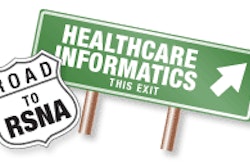Inappropriate and/or unnecessary radiation dose exposure from CT scans and radiation therapy is still in the top 10 list of health technology hazards published annually by research and consulting group ECRI Institute.
Concern about radiation dose did diminish somewhat in the 2012 report compared to last year, when radiation therapy errors topped ECRI's list as the No. 1 hazard. Concern about use of unnecessarily high radiation dose and inappropriate utilization of CT scans followed close behind, as the fourth highest concern.
In ECRI's new 2012 report, these two items have been combined as "exposure hazards from radiation therapy and CT" and listed as the No. 2 health hazard to patients. Failure of alarm systems on medical devices such as dialysis units, physiological monitors, and infusion pumps now has the No. 1 hazard ranking.
This year, concern about healthcare IT data loss -- No. 5 in the 2011 list -- has been replaced with inattention to change management for medical device connectivity, with failure in PACS integration specifically referenced. Healthcare IT data loss has dropped off ECRI's list of hazards entirely.
Preventing radiotherapy hazards
ECRI recommends that hospitals implement robust measures to control the "complicated risks" that can be caused by radiation therapy devices and CT scanners. With respect to radiation therapy adverse incidents, it noted that these can have devastating consequences that include ineffective tumor control, critical damage to normal tissues, and possible death.
"It isn't clear how many patients are affected by radiation therapy errors -- for one thing, there isn't an unambiguous definition of a reportable event -- and there is a good chance that incidents are being significantly underreported," the authors wrote.
Noting that there is no simple fix to guarantee the safe and effective use of radiotherapy equipment, ECRI recommends that departments be accredited and certified, that staffing levels are adequate, and that a comprehensive, rigorous quality assurance program, including peer review, is maintained. Additionally, new equipment and software updates need to be properly installed, commissioned, tested, and maintained with equipment capable of performing these functions.
ECRI also recommends that radiation therapy departments have standard patient treatment protocols with documented use, and that checklists are followed, clinical staff is trained, new treatment techniques are validated, and "time out" triggers are followed with corrective action.
Preventing CT scan hazards
ECRI expressed concern about the frequency with which CT exams are being ordered, and that failure to implement and mandate the use of low-dose protocols is exposing patients to unnecessarily high radiation levels. The report also expressed concern about inappropriate use of CT exams.
ECRI recommends that radiologists and medical physicists be available for consultation with all medical staff. Staff members should be educated about the appropriate use of diagnostic imaging, they should implement low-dose protocols and validate all study protocols before routine use, and they should maintain an audit program of radiation doses, according to ECRI.
Medical device connectivity hazards
Healthcare IT professionals should not be complacent about medical device interfaces with IT systems. Noting that the growing interrelationship of medical technology and IT offers significant benefits, ECRI also warned of potential risks to patients if interfaces are poorly implemented. The report identifies hazards originating from degraded network performance, software glitches, and system interoperability issues.
ECRI has observed increasing problems involving wireless networks, cybersecurity, planned maintenance, and software upgrades. It recommended implementing change management using a structured approach and good working relationships among the staff of all departments involved.
Other items in the new top 10 list include the following:
- No. 3: Medication administration errors using infusion pumps
- No. 4: Cross-contamination from flexible endoscopes
- No. 6: Enteral feeding misconnections
- No. 7: Surgical fires
- No. 9: Anesthesia hazards due to incomplete pre-use inspection
- No. 10: Poor usability of home-use medical devices
A complete copy of the report can be accessed by clicking here.



















